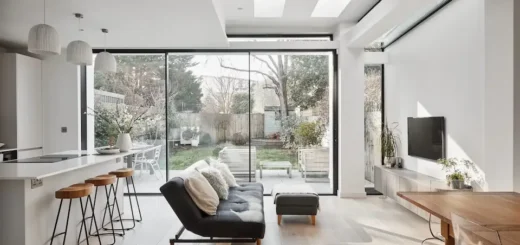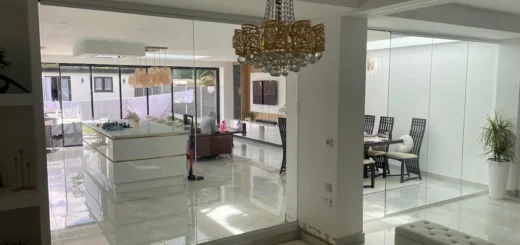Choosing Sliding Back Doors: Buyer’s Guide & Tips
Table of Contents
Modern sliding back doors offer more options than ever, with frame materials and design styles to match any home style. Your choice of door material, frame thickness, and opening mechanism shapes how the doors look and work in your space.
Aluminium vs uPVC: Which Material Suits Your Home?
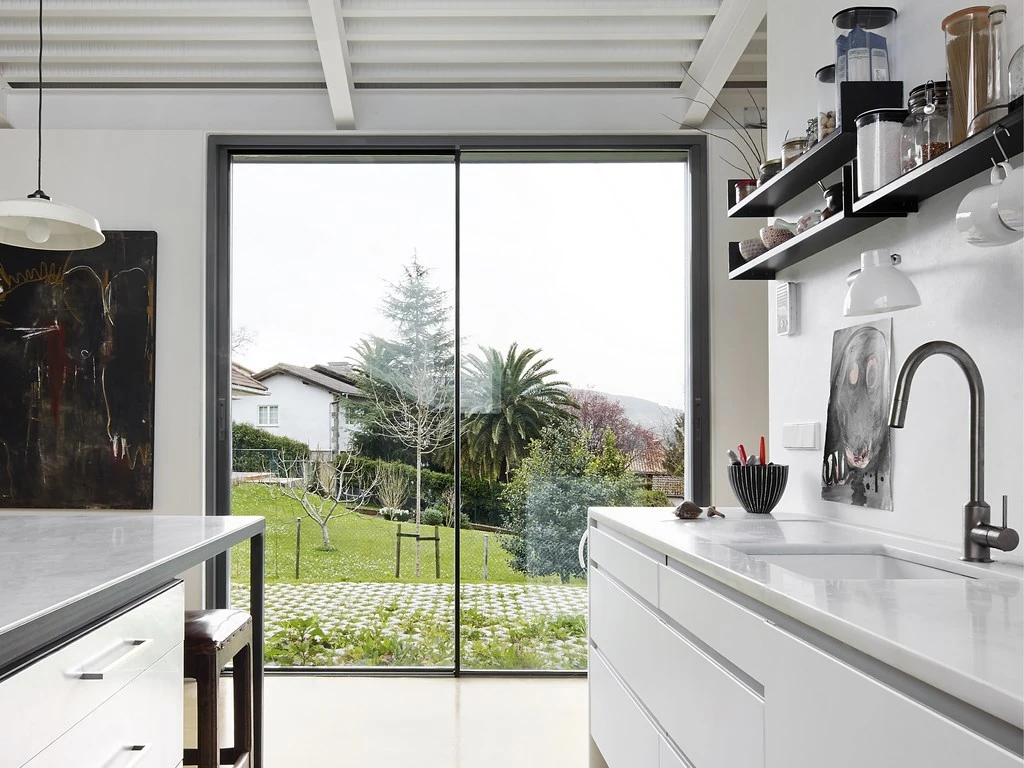
Aluminium frames cost more than uPVC but bring distinct advantages. Powder coated aluminium doors resist weathering and maintain their colour for decades, while uPVC might yellow or discolour over time. The strength of aluminium allows for thinner frames, bringing in more light through larger glass panels.
Beyond durability, aluminium frames offer superior rigidity. The inherent stiffness of aluminium slide doors means less flex when opening and closing, particularly important for wider openings where uPVC might catch or stick. Yet uPVC’s lower price point makes it a practical choice for smaller openings or when working to a tight budget.
Paint and finish options vary between materials too. While uPVC comes in a limited range of colours and woodgrain effects, aluminium frames can be finished in virtually any colour through powder coating. This flexibility lets you match existing windows or create striking contrasts with your interior design scheme.
Two vs Three Panel Configurations
Sliding back doors commonly come in two-panel designs, where one panel slides past a fixed pane. For wider openings, three-panel configurations offer more flexibility – you can slide panels from either end or fix the centre panel. The number of panels you choose depends on your available wall space and how you plan to use the doors.
Larger panels mean fewer frame lines interrupting your view, but they add weight to the mechanism. Three-panel designs split the weight across more rollers, often resulting in smoother operation. They also offer varied opening positions, letting you partially open different sections for ventilation.
Ultra-Thin vs Standard Frames
Slim frames maximise glass area and minimise visible frame width. The structural properties of aluminium frames allow manufacturers to reduce visible frame profiles to remarkably narrow widths. While standard frames might be chunky and obvious, slimline options almost disappear from view.
The visual impact of frame thickness becomes more noticeable as door sizes increase. Where standard frames might look proportional on smaller openings, they can appear heavy and industrial on larger sliding back doors. Yet slim frames cost substantially more, so it’s worth weighing up whether the extra glass area justifies the price difference.
Threshold Types and Door Mechanisms
Opening Mechanisms
The way sliding back doors open and close makes a big difference to their daily usability. Inline sliding systems roll directly on their track, suiting regular domestic use. Lift-and-slide mechanisms raise the door panel slightly before sliding, reducing roller friction and making even heavy panels move with minimal effort.
Low-threshold options remove the step between inside and outside, creating a flush floor level. However, this requires careful planning of drainage and floor levels during installation. Raised thresholds provide better weatherproofing but introduce a small step to step over.
Track design varies between systems too. Double or triple tracks allow panels to slide independently, while single tracks restrict movement options but offer simpler operation. Multi-track systems suit three-panel configurations particularly well, as they allow more flexible opening patterns.
Styling Your Home with Sliding Back Doors
The visual impact of large glass doors goes far beyond bringing in extra light. Your choice of frame colour, style and finish shapes the character of your room and can turn a standard door into an architectural feature.
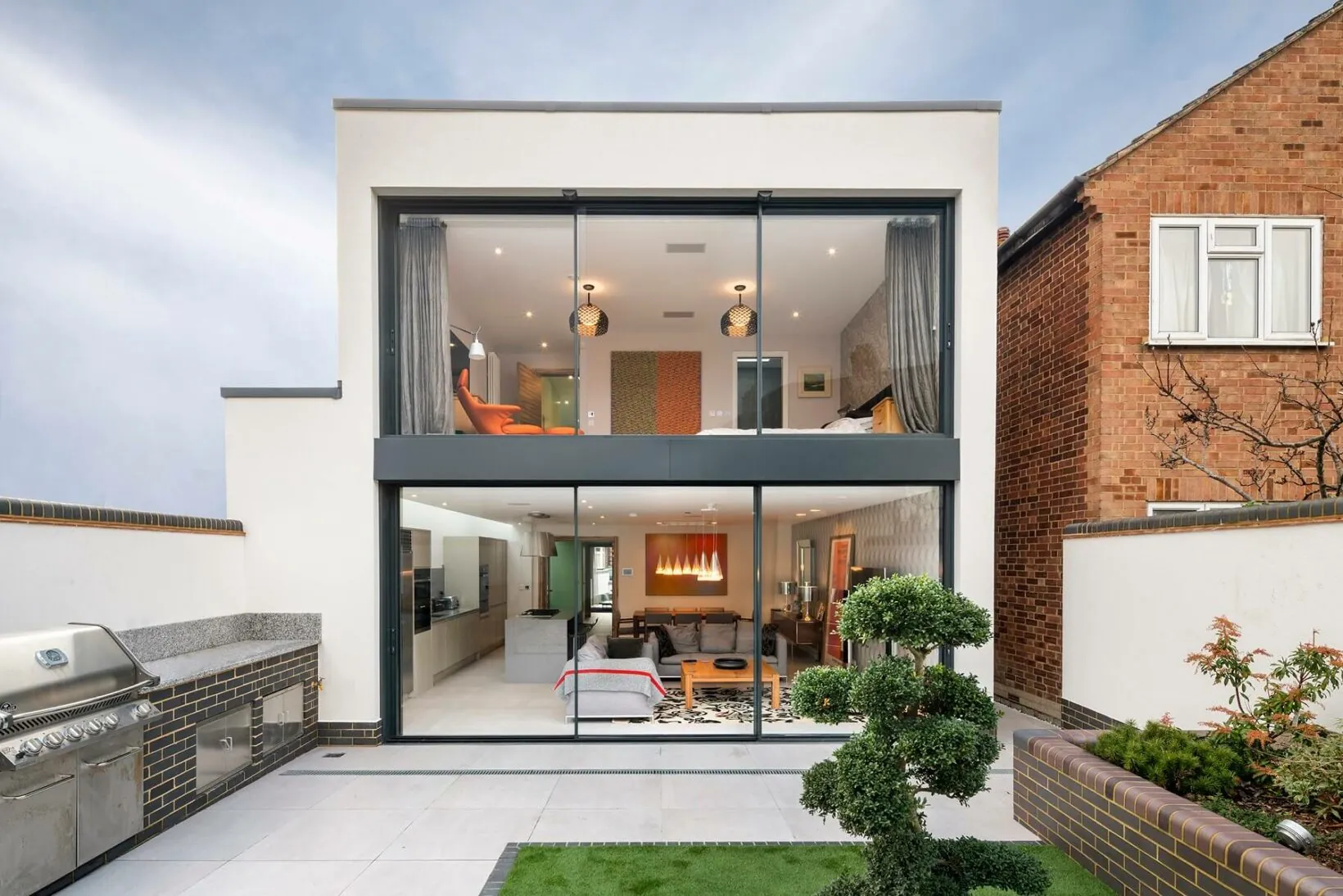
Frame Colours and Your Interior
Dark-coloured sliding back doors create striking contrasts against pale walls, while lighter frames suit period properties where traditional features need to remain the focus. Anthracite patio doors pair particularly well with contemporary furniture and monochrome colour schemes.
Paint finish quality matters as much as colour choice. Matt finishes reduce glare and help frame lines recede, making the glass appear more prominent. Metallic finishes catch the light differently throughout the day, adding subtle movement as the sun’s position changes. Gloss finishes bring a modern edge but show fingerprints more readily.
When choosing frame colours for sliding back doors, look at your space in different lights. Strong sunlight intensifies colour, while overcast days mute it. Dark frames can look striking on bright days but might feel imposing on gloomy afternoons. Keep paint samples in your space for several days before deciding.
Making Sliding Back Doors Work in Period Homes
Frame Styles for Traditional Properties
Heritage sliding doors offer modern performance while respecting traditional aesthetics. Slender glazing bars divide large glass panels into smaller sections, matching the proportions of original sash windows. This approach works especially well in Victorian and Edwardian homes where maintaining architectural consistency matters.
Aluminium patio doors might seem an unlikely fit for older houses, but careful design choices help them integrate naturally. Choosing frame profiles that mirror existing window depths maintains visual harmony. Woodgrain finishes can complement original joinery while providing modern thermal performance.
Modern sliding glass back doors can actually highlight period features rather than compete with them. Clean lines draw attention to ornate cornicing or original fireplaces. The key lies in choosing frame proportions that respect the original architecture – too thin and they’ll jar with chunky traditional mouldings, too thick and they’ll overwhelm delicate period details.
Frame Finishes that Last
Surface treatment determines how well your door finish withstands daily use. Powder coating creates harder-wearing surfaces than wet paint, resisting chips and scratches. Anodised finishes penetrate the metal itself, providing excellent durability but limiting colour options.
Textured finishes hide minor marks better than smooth ones. They’re particularly useful near kitchen areas where splashes and cleaning might mar glossier surfaces. However, deeper textures can trap dirt over time, requiring more thorough cleaning to maintain their appearance.
Metal effects like bronze and steel bring industrial character to contemporary spaces. Unlike real metal, these finishes won’t develop a patina over time – they’ll look the same year after year. This consistency suits modern homes but might feel out of place in more traditional settings.
Real wood veneers require regular maintenance to keep their natural beauty. While they bring warmth and character, they need periodic treatment to prevent UV damage and moisture absorption. Modern woodgrain effects offer similar visual appeal with much lower maintenance needs.
Hardware and Interior Fittings
Handle design influences daily interaction with sliding back doors. Chunky handles provide easier grip but dominate visually, while minimal designs disappear into the frame. D-handles suit most users while flush pulls create cleaner lines but might be harder for some people to operate.
Matching door hardware to existing fittings creates visual continuity. Rather than exactly matching metals, aim for complementary finishes – brushed steel works well with chrome, while black hardware suits both modern and traditional spaces. Think about how the finish will wear – some metals develop attractive patinas while others just look worn.
Lock mechanisms need particular attention. Multi-point locking systems improve security but add visible details to the frame. Consider whether lock cylinders should match your existing door furniture or blend into the frame colour. Some systems allow cylinder replacement without changing the whole lock, making future updates easier.
Design Details for Sliding Back Doors
Practical choices about lighting, furniture placement and floor levels determine how well your doors work in daily life. Getting these details right makes living with large glass doors more enjoyable and practical.
Lighting for Glass Doors
Night lighting needs careful planning around sliding back doors. Strong interior lights create reflections that turn glass into mirrors after dark. Wall lights positioned away from the glass reduce glare while still providing useful light. Dimmer switches let you adjust light levels to suit different times and activities.
External lighting changes how glass patio doors look from inside and out. Up-lighting from ground-level spots creates atmosphere without harsh glare. Path lights guide movement through darker areas while keeping direct light away from the glass. Garden lighting placed too close to exterior glass doors produces distracting reflections that bounce back into your room.
Managing Light and Reflection
Window coverings need different approaches for sliding glass back doors. Standard curtain poles often can’t span wider openings without extra support. Track systems fitted to the ceiling provide better support for heavier curtains. Wave-style headings create softer folds that stack back neatly without blocking light or views when open.
Sunlight streaming through large glass areas might need tempering. Modern glass coatings cut glare but can’t eliminate it entirely. Sliding panels or vertical blinds offer flexible control over light and privacy. Light-filtering fabrics maintain views while reducing brightness.
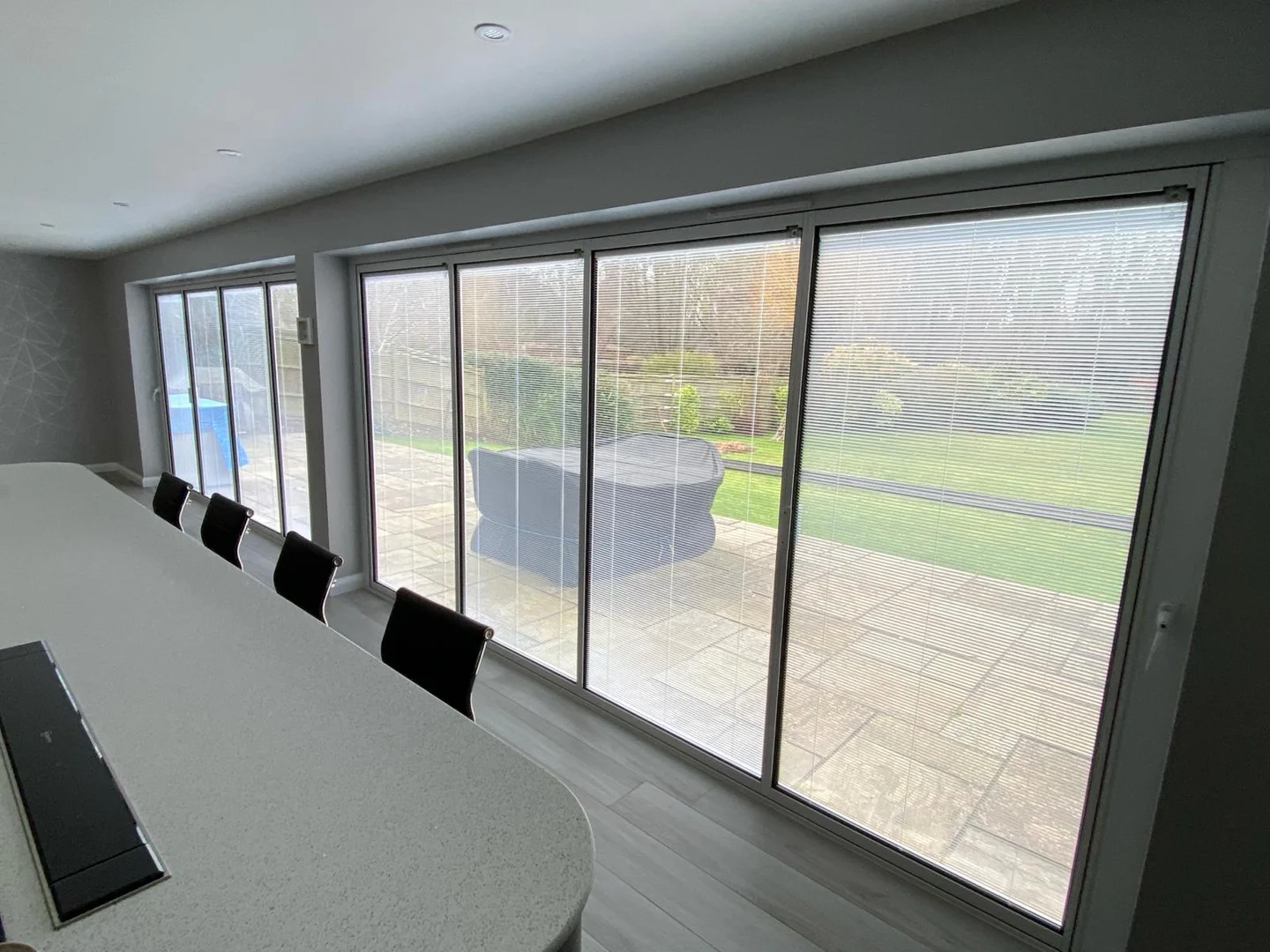
Furniture Placement Around Large Doors
Modern style layouts often struggle with sliding back doors. Conventional seating arrangements pointing at televisions or fireplaces might block access or views through the glass. Turning furniture at angles can maintain clear paths while still allowing people to enjoy the view.
Low-backed seating works well near glass doors – it doesn’t block light or create visual barriers. L-shaped sofas define living areas without cutting off access to the doors. Coffee tables placed parallel to the doors leave clear walking routes while providing useful surface space.
Dining tables near sliding doors need space for chairs to pull out without hitting the glass. Round tables use space more efficiently than rectangular ones, especially in tighter spots. Extending tables offer flexibility for different group sizes without permanently blocking door access.
Floor-Level Design
Floor levels need careful planning around sliding back doors. Small differences in height between inside and outside create trip hazards. Drainage falls directing water away from the threshold might affect how level your interior floor appears. Getting these details right during installation prevents problems later.
Different flooring materials meeting at door thresholds need careful detailing. Stone or tile floors can usually run right up to the frame. Wooden floors might need expansion gaps hidden under trim pieces. The choice of threshold detail influences which flooring options work best.
Natural stone flooring brings outdoor materials inside, creating visual links through sliding glass back doors. Porcelain tiles offer similar looks with easier maintenance. Whatever material you choose needs to withstand traffic and cleaning without showing wear patterns where people regularly walk.
Window Dressing Large Glass Doors
Privacy needs change throughout the day with external doors. Sheer curtains provide daytime privacy while keeping views and light. Room-darkening options might be essential for bedrooms or media rooms. Remote-controlled blinds make adjustment easier, especially for high or hard-to-reach windows.
Custom blinds designed specifically for sliding back doors offer neat solutions. Side-mounted systems don’t interfere with the door operation. Top-mounted designs need careful planning to avoid blocking the sliding mechanism. Pleated blinds fold away more compactly than roller styles but might not suit every décor style.
Solar control films provide another option for managing light and privacy. Modern films cut heat and glare without darkening rooms excessively. Some types even help hold broken glass together, adding an extra layer of security. Professional installation ensures bubble-free results that last longer than DIY applications.
Decorating Around Sliding Back Doors
Large expanses of glass change how we use and style our homes. The right decorative touches make glass doors feel like natural parts of your living space rather than jarring modern additions.
Plants and Natural Elements
Carefully placed greenery softens the lines of sliding back doors without blocking light or views. Tall plants in corners draw the eye upward, making ceilings appear higher. Low-growing specimens under the glass add life without creating barriers.
Indoor plants near wide patio doors need extra care. Glass magnifies sunlight, potentially scorching leaves. Moving pots slightly away from the glass prevents damage while maintaining the visual connection. Choosing plants that thrive in bright conditions ensures they stay healthy throughout the year.
Large sliding back doors create perfect conditions for growing indoor trees. The abundant natural light supports bigger specimens that might struggle elsewhere in the house. Placing trees at angles rather than directly in front of the glass maintains clear sight lines while adding structural interest.
Seasonal Plant Selection
Spring and summer demand different approaches than autumn and winter. Evergreen plants provide year-round structure near sliding glass back doors. Deciduous varieties add seasonal interest but might look sparse in winter. Mixing plant types ensures the space stays interesting as seasons change.
Container gardens near double doors need regular maintenance. Automated watering systems help when access is awkward. Self-watering pots reduce maintenance needs while keeping plants healthy. The right pot size balances visual impact with practical factors like weight and water retention.
Flooring and Soft Furnishings
Rugs near sliding back doors face unique challenges:
- Water resistance matters more than in other areas
- Pile height should allow doors to slide freely
- Materials need to withstand increased UV exposure
- Backing must grip well without marking floors
- Size should define spaces without blocking movement
Natural fibre rugs like sisal or jute handle high-traffic areas well but might fade in strong sun. Synthetic options offer better fade resistance and easier cleaning. Outdoor-rated rugs bring surprising durability to indoor spaces near large sliding back doors.
Cushions and throws add comfort while connecting indoor and outdoor colours. Sun-resistant fabrics prevent fading where light levels are high. Removable covers make seasonal changes easier and help maintain fresh appearances throughout the year.
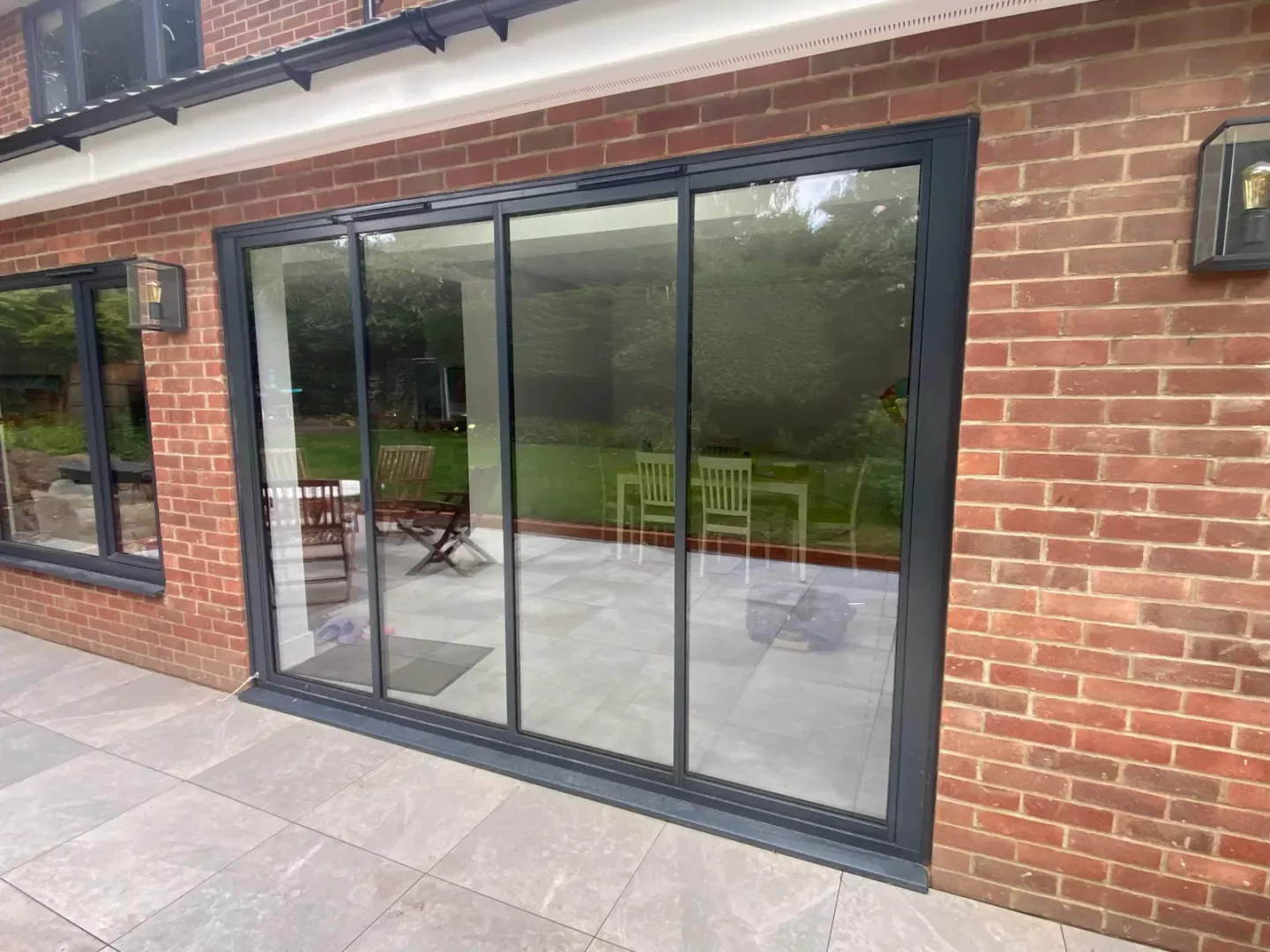
Bold Colour Choices
Frame colours for sliding back doors offer opportunities for striking design statements. Dark frames against light walls create architectural interest. Matching frames to wall colours makes them disappear visually. Contrasting colours highlight the doors as intentional design features.
Paint colours near glass need special attention. Strong sunlight through sliding glass back doors intensifies wall colours. What looks perfect on a paint card might feel overwhelming when light pours through. Testing colours under different lighting conditions prevents expensive mistakes.
Wall colours facing large sliding back doors influence how the space feels at different times. Lighter shades reflect more light back into the room. Deeper tones add richness but might darken the space. Mid-tones often strike the best balance between interest and practicality.
Pattern and texture near glass bring depth without overwhelming the space. Textured wallpaper catches light differently throughout the day. Subtle patterns add interest without competing with views. Strong patterns need careful placement to avoid creating visual chaos.
Paint finishes matter as much as colours around patio doors. Matt finishes reduce glare but show marks more easily. Pearl finishes hide imperfections while maintaining depth. The right finish balances practical needs with aesthetic goals.
About SunSeeker Doors
With over 20 years of experience, SunSeeker Doors remains at the forefront of door design with our quality-tested patio doors and related products, including the bespoke UltraSlim aluminium slide and pivot door system, Frameless Glass Doors, and Slimline Sliding Glass Doors. All of our doors are suitable for both internal and external use.
To request a free quotation, please use our online form. You may also contact 01582 492730, or email info@sunseekerdoors.co.uk if you have any questions.


